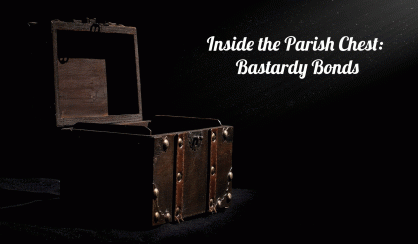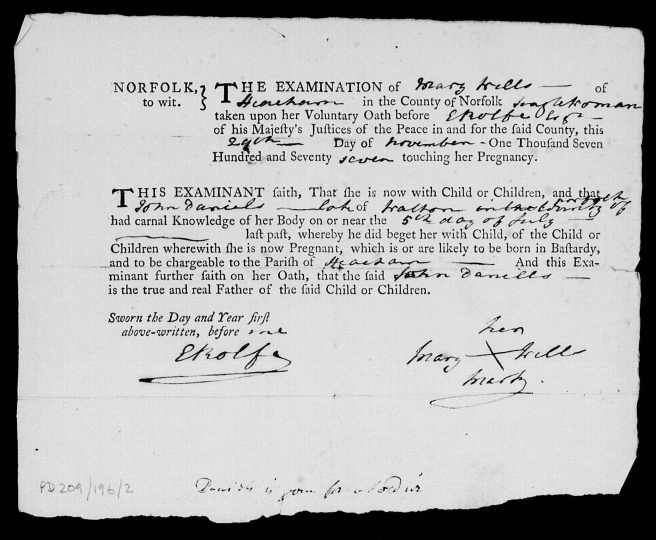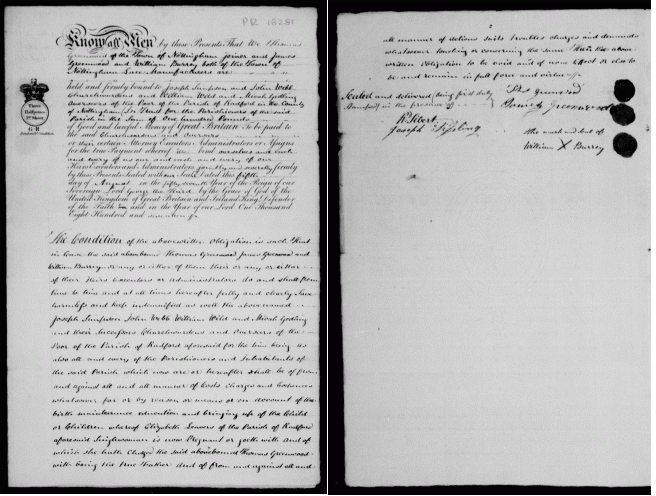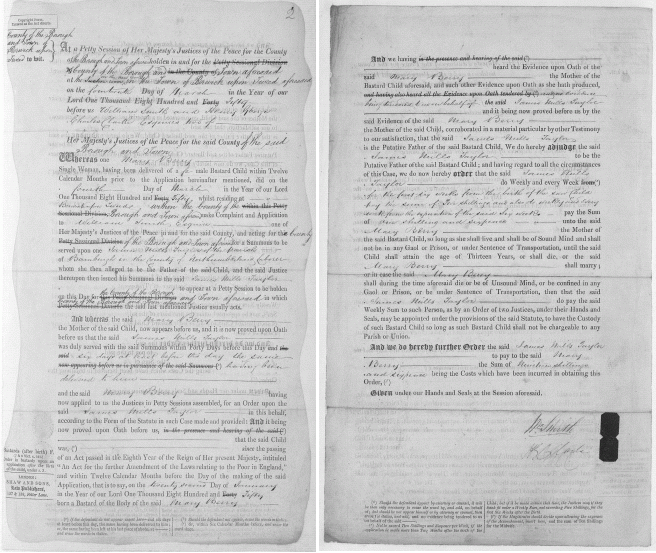
Bastardy Bonds can be a great resource when trying to locate a birth date and place when vital records may not exist or in placing someone in a specific area at a specific time. In England, these records were created on a parish level before 1834 and on county and poor law union levels beginning in 1834. They are part of a collection of records falling under the title of Parish Chest records. Parish chests were literally chests where the parish kept their records. Ranging from Vestry Minutes to Churchwarden and Poor Rate accounts, to Bastardy Bonds and Apprentice records, these documents recorded the daily workings of the local parish.
Parishes were concerned with not being held financially liable for the birth and upbringing of a child born to an unmarried woman. By the laws of the time, that child, born to an unmarried woman, was considered illegitimate. An unmarried mother faced substantial social stigma in addition to financial hardship. Through a prescribed path, the parish ensured that the financial responsibility for the child would fall on the father. This was especially so in cases where the putative father did not or would not take responsibility.
Bastardy Examinations
When a father would not step forward, the parish would often put pressure on the mother to name the child’s father. This was done under oath and carried out by the Churchwarden or Overseer of the Poor. Their authority came to them from the Bastardy Act of 1575 which allowed them to question an unmarried mother in order to get her to reveal the name of the father.

In the example above, Mary Wells, a single woman, declares upon her oath before the Justices of the Peace on the 29th Day of November 1777 regarding her pregnancy. She states that she is with child and names John Daniels, as having carnal knowledge of her body, on or near the 5th day of July and that she is now pregnant and the child likely to be born in bastardy. She leaves her mark at the bottom of the page.1
With the father so named, the Churchwardens or Overseers of the Poor would exert considerable pressure on the father to take financial responsibility for the child in the form of a Bastardy Bond.
Bastardy Bonds
This bond of indemnification or bastardy bond ensured that the father was responsible for the child. The bond indemnified or compensated the parish against any future costs until the child was thirteen years of age or had been apprenticed out. Few men could afford to pay the bond from their own resources, therefore most would have friends or relatives sign as surety on the bond.

In the above example, dated 5 August 1817, Elizabeth Leavers, single woman, of the parish of Radford, has sworn by oath that she is now pregnant with a child by Thomas Greenwood. Thomas Greenwood, and two other men, James Greenwood and William Burrey, all of the town of Nottingham, have signed this bond, indicating Thomas’ acceptance of the charge and his assurance that he will maintain the child. The men have, under oath, sworn that a bond of £100.00 would be payable to the Churchwardens and Overseers of the Poor of the Parish of Radford in the County of Nottingham, should Thomas Greenwood fail to take care of the child.2
Bastardy Bond recorded in the Petty Sessions
After the New Poor Law of 1834, the parish authorities lessened their role in bastardy cases leaving the woman the option of applying herself for the bond from the Petty Sessions.

In this example, Mary Berry, a single woman, has appeared before the Justices of the Peace in the County of the Borough and Town of Berwick-upon-Tweed on 14 March 1850. The bond states that Mary Berry was delivered of a female bastard child within the twelve months previous. She names James Mills Taylor of the Parish of Bamburgh in the County of Northumberland, a laborer, as the father. A summons was issued for James Mills Taylor to appear at the Petty Session. Towards the bottom of the page, an exact date of birth is given for the child, 22 January 1850. Mary Berry has provided enough evidence that the Justices of the Peace declare they are satisfied and they declare James Mills Taylor the putative father. He is ordered to pay Mary Berry an amount of 5 shillings weekly for the first six weeks from the birth of the child. He is further ordered to pay the sum of one shilling and sixpence to Mary Berry until the child is 13 years of age. There were some conditions to this: should Mary Berry be of unsound mind, or in jail or under sentence of transportation or should she remarry, the payment would go to whoever was declared the child’s custodian. Should the child die before his thirteenth birthday, Mary Berry would no longer receive any monies. Further, the father, James Mills Taylor, was also to pay Mary Berry, 19 shillings and sixpence, the costs incurred in obtaining the order.3
Where to find Bastardy Bonds
For England records:
Parish chest records are listed in the Place Search of the FamilySearch Catalog under:
- England, [county name], [parish name] – Church records
- England, [county name], [parish name] – Poorhouses, Poor Law
- England, [county name], [parish name] – Taxation
Most bastardy bonds are kept on the county level in England and are not online. Many county record offices have an online presence that may allow you to determine if they hold such records and what the cost may be in accessing them.
For US records:
- If you are lucky enough to be researching in North Carolina, they have extensive records for each county.
- Other states have bastardy bonds, but they are not as extensive. To see what is available on the FamilySearch Catalog, a keyword search of “bastardy bonds” can be used to indicate which counties kept these records. To narrow down the search even more, include the state or the state and county that you are researching in to see what is available. These bonds are not yet indexed.
- The bastardy bonds are not likely online for every county. They may be found in person at the county courthouses, if still preserved.
- For FindmyPast.com a search in the A-Z of Record Sets with the keywords ‘bastardy bonds’, ‘parish chest’ or ‘Poor Law’ will locate records.
- For Ancestry.com search the Card Catalog with the terms ‘bastardy’, ‘poor law’ or ‘quarter sessions’.
Have you used bastardy bonds in your research?
This is the first post in a series on Parish Chest records.
Coming up next: In the Parish Chest: Settlement and Removal Certificates
- Norfolk County, North Elmham Parish, Bastardy Examinations, 1765-1811, Examination of Mary Wells, 29 November 1777; images, FamilySearch (https://www.familysearch.org/ark:/61903/3:1:S3HT-62T7-ZZL?cat=1013166 : accessed 20 August 2018). ↩
- Nottinghamshire County, Court of Quarter Sessions of the Peace, Bastardy Bonds, 1817-1818, 5 August 1817, Elizabeth Leavers to Thomas Greenwood on bastardy charge; images, FamilySearch (https://www.familysearch.org/ark:/61903/3:1:3Q9M-CSNW-C3Z8?cat=635885 : accessed 20 August 2018, images 719 & 729 of 1934). ↩
- “England, Northumberland, Cumberland, Durham, Miscellaneous Records, 969-2007,” images, FamilySearch (https://familysearch.org/ark:/61903/3:1:3QS7-L93Y-2HHN?cc=1918635&wc=7VZB-7V7%3A209394801%2C210421601%2C210422501 : 20 May 2014 : accessed 21 August 2018), Northumberland > Berwick-upon-Tweed > Bastardy bonds, 1850-1859, image 2 of 214; Northumberland Archives Service, Ashington. ↩


Thanks so much for sharing this information. It’s a topic I know little about but having not found a birth record for my great-grandfather in Northumberland in 1860, I was wondering if he may have been born before his parents were married. I’ll see if I can find Parish Chest records for the area.
LikeLiked by 1 person
Wishing you the best of luck in your search, Nancy! These parish chest records are really so valuable – I just wish more were online!
LikeLike
Oops, I missed that typo. The Record Offuce should have read Lancashire.
LikeLiked by 1 person
I was lucky enough to find at Kancashire Recird Office (England)an 1810 bastardy bond regarding my ancestor John Danson. The poor child was never named butbreferred to continually as “the said bastard child”. The document named the mother, but I have been unable to trace anything more about her.
LikeLike
It is jarring to see our ancestors referred to that way. Thank goodness we have moved away from the use of that term. How lucky you were to find an 1810 bastardy bond! Just unfortunate that the children were never named in them!
LikeLike
Great post! I hadn’t really thought about looking here but will give it a try.
LikeLiked by 1 person
I hope you have some luck in looking at bastardy bonds. I’m still trying to trace an ancestor of mine in County Durham, England who was illegitimate, so far haven’t found him or his mother but I’m going to keep looking!
LikeLike
Enjoyed this post very much! I ran across one bastardy bond in my research in North Carolina, but did not understand the purpose of the document. Thank you for the explanation. They sound like a useful resource!
LikeLiked by 1 person
North Carolina has some really great bastardy bond collections. I was impressed to see how many were online. It’s definitely not the case for most areas.
LikeLike
Very interesting. I had never heard of any of this before. Thanks for a great explanation!
LikeLiked by 1 person
They really can be a great wealth of information. Actually many of the Parish Chest records can fill in gaps in research that no other records can. Thanks for stopping by!
LikeLiked by 1 person